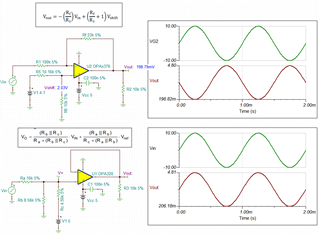Javier,
I found the https://www.ti.com/lit/an/sbaa374/sbaa374.pdf useful ,
Now Q1: shall we use OPA2350 or LM358 instead of OP320 ?
q2: what is the different between Tidu015.pdf and sabaa374?
thanks for attention.
Dave.
This thread has been locked.
If you have a related question, please click the "Ask a related question" button in the top right corner. The newly created question will be automatically linked to this question.
Hi Dave,
Driving an ADS input as shown in sbaa374 is not a trivial task, and the correct op amp and RC circuit must be selected. That is the subject that Art Kay is covering in "Noninverting circuit for high-to-low voltage level translation to drive ADS." The OPA320 is a good choice for the application because it has the speed and output characteristics needed to drive the highly dynamic input of the ADS.
The OPA350 is a robust output op amp with high bandwidth and is very often applied as an ADS driver, but the output RC network values derived may be different than those optimized for the OPA320. The LM358 that you mention is not suitable for the ADS8860 application if high performance is to be maintained. It is a very different op amp than the low-voltage, CMOS OPA320 and OPA350.
TIDU015.pdf, Level Translation: Dual to Single Supply Amp, ±15V to 5V, is used to translate a +/-15 V input to a 0 to 5 V input range. This is useful for lower voltage, analog circuits with a 0 to 5 V input range. It isn't optimized for driving most ADS converters, but may be useful if the converter has a built-in input buffer. The performance of the circuit will be dictated by the op amps used in the circuit. Art provides some comparison tables in the report regarding the op amp electrical performances; Table 6. Brief Comparison of ±15V Supply Amplifiers, and Table 7. Brief Comparison of 5V Supply Amplifiers, that should help make the selections easier.
Regards, Thomas
Precision Amplifiers Applications Engineering
Hi Dave,
Thom has replied to your inquiries.
Since I have made comparisons between two applications, it will be good to present the graphs in addition to Thom's comments.

OPA376 Dual2Single supply 03172021.TSC
OPA320 hi2low voltage translation 03172021.TSC
Please let us know if you have additional questions.
Best,
Raymond
thanks dear Raymond. Perfect !
would you please let me know which software are you using for simulation?
thanks a gain for your help :).
Dave.
dear Thomas,
first of all I want to thank you ,since you put a lot of time explaining about it .
Q1:my target is using flux gate (LEM) sensor 200A~1000A ,as you may know the out put of it is +15V~ -15V and I have to translate it to3.3v ,in as far as I know motor control application the speed of waveform is less than 400Hz in most cases .do you think it still need high speed opamp ?
Q2: sorry I couldn't get , would it be possible to use OPA2350 instead of OPA320 in motor control Application?
thanks for attention.
Dave.
Hi Dave,
You are able to download the free Tina Simulation software from the link below.
https://www.ti.com/tool/TINA-TI#downloads
If you have other questions, please let me know.
Best,
Raymond
Hi Dave,
It is my pleasure to assist you. Regarding your questions:
Q1:my target is using flux gate (LEM) sensor 200A~1000A ,as you may know the out put of it is +15V~ -15V and I have to translate it to3.3v ,in as far as I know motor control application the speed of waveform is less than 400Hz in most cases .do you think it still need high speed opamp ?
Okay. Do recognize that Art's circuit was set up for a +/-10 V input range so the input divider/level shift resistor network will need to be recalculated for that input range ane the 0 to +3.3 V output range. Fortunately, I developed a TI Precision Design where I go through the math to do that. Please see Section 2.2, 3-Resistor Input Network, in tidu039:
https://www.ti.com/lit/ug/tidu039/tidu039.pdf
The input network in the TI Precision Design fed into a comparator input, but it can be used just as well with an op amp connected as in Art's SBAA374 circuit. 400 Hz is a low frequency so your application should be fine with many of our moderately fast precision op amps as the OPA320, or OPA350.
Q2: sorry I couldn't get , would it be possible to use OPA2350 instead of OPA320 in motor control Application?
The OPA2350 dual op amp would serve well in the ADS driver application. Maybe you can find a use for the additional op amp section the dual.
Regards, Thomas
Precision Amplifiers Applications Engineering